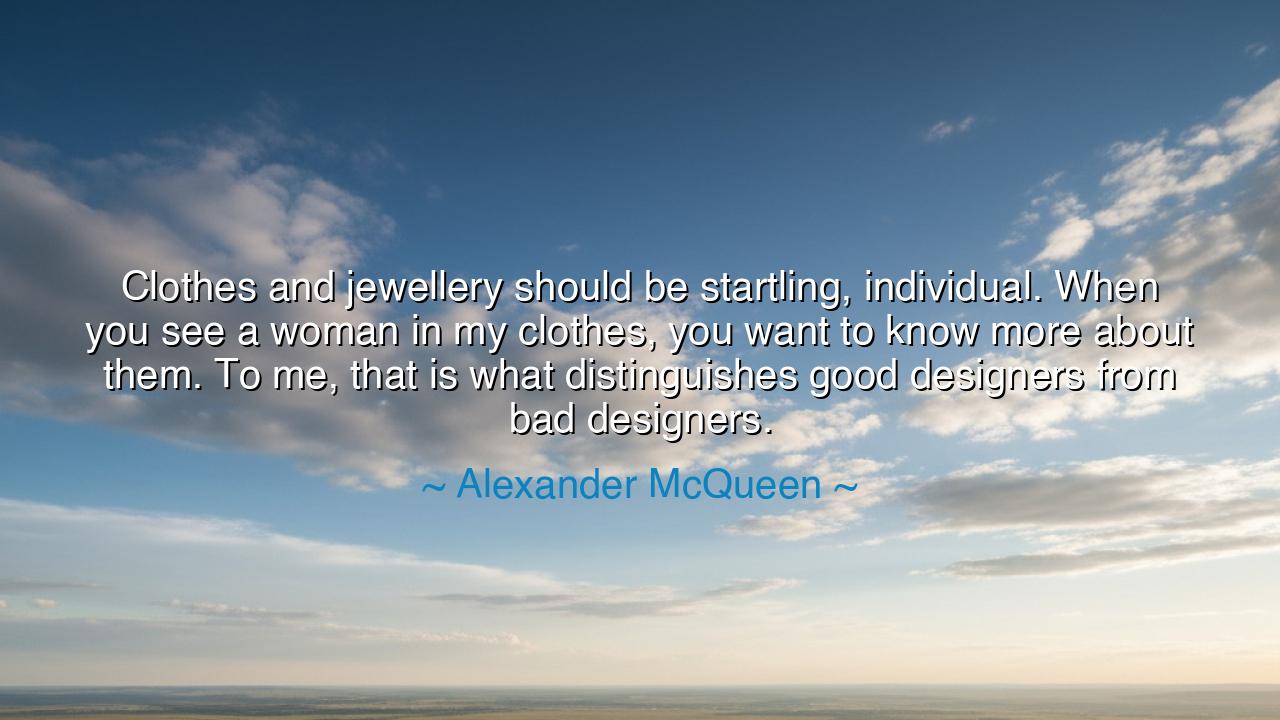
Clothes and jewellery should be startling, individual. When you
Clothes and jewellery should be startling, individual. When you see a woman in my clothes, you want to know more about them. To me, that is what distinguishes good designers from bad designers.






The visionary designer Alexander McQueen, whose creations walked the fine line between beauty and rebellion, once declared: “Clothes and jewellery should be startling, individual. When you see a woman in my clothes, you want to know more about them. To me, that is what distinguishes good designers from bad designers.” In this statement, fierce yet poetic, McQueen reveals the essence of true design — that it is not merely about adornment, but about identity, emotion, and the power to stir curiosity in the soul of the beholder. His words are not just the musings of a fashion designer; they are the manifesto of an artist who saw clothing as a mirror of the human spirit — wild, complex, and defiantly alive.
For McQueen, fashion was not decoration; it was revelation. He believed that every garment, every piece of jewellery, should speak — not in whispers of conformity, but in the bold, unapologetic voice of individuality. To be startling is to awaken; it is to break through the dull fabric of ordinary life and remind the world that beauty and power are born in difference. His designs — the razor-sharp tailoring, the haunting silhouettes, the blending of elegance and savagery — embodied this philosophy. When he said that one should want to know more about the person wearing his clothes, he was describing a kind of alchemy — the transformation of fashion into story, of fabric into emotion.
The origin of McQueen’s perspective lies in his own journey, forged in hardship and defiance. Born in East London, far from the luxury of the fashion elite, he learned the craft of tailoring in the humble shops of Savile Row before rising to global renown. His life was marked by struggle — between darkness and light, tradition and rebellion, pain and beauty. It was this tension that gave his art its raw power. He did not design to please the crowd, but to challenge it. To him, a good designer was one who provoked feeling, who dared to express truth even when it unsettled the comfortable. The bad designer, by contrast, sought only approval — creating garments that filled space but not the imagination.
History, too, bears witness to this truth. In every age, the artists who endure are those who dared to shock and inspire. Coco Chanel, in her time, broke the chains of corsetry and declared that women should dress for freedom, not for servitude. Elsa Schiaparelli, her rival, merged art and fashion, turning the surreal visions of Dali into wearable dreams. Like McQueen, they understood that style must carry the weight of meaning — that to dress is not only to cover the body, but to express the soul. Their designs were startling not because they sought attention, but because they revealed authenticity.
McQueen’s words also contain a deeper, almost philosophical teaching about individuality. In a world that often demands conformity, he urged people to embrace the beauty of their differences. To wear something “startling” is not to seek shock for its own sake, but to declare, “This is who I am.” It is an act of courage, for true individuality always risks misunderstanding. Yet, as McQueen believed, it is better to be misunderstood than unseen. Fashion, to him, was not vanity but freedom — the freedom to exist fully, without apology, without fear.
His philosophy resonates far beyond the runway. It speaks to artists, thinkers, and dreamers in every field: to create something worthwhile, one must be bold, personal, and unafraid. The great works of history — from Michelangelo’s David to Frida Kahlo’s self-portraits — were born from the same fire that burned in McQueen’s heart: the refusal to imitate, the determination to reveal. The desire to astonish, not with spectacle, but with truth. In every act of creation, whether one shapes metal, paints, words, or fabric, the same law applies: only that which carries the imprint of the individual endures.
So, my listener of the future, take this lesson from Alexander McQueen — do not strive merely to fit in; strive to express. In your work, your art, your life, let there be something of the startling — something that makes others pause and wonder who you are, and what fire moves you. Be as the good designer, crafting not for approval but for meaning. Make your choices in dress, in words, in deeds, a reflection of your truest self.
For in the end, McQueen’s wisdom is not about fashion at all — it is about being alive. To live as he taught is to refuse to fade into uniformity, to stand as both question and answer in a world too easily satisfied with imitation. Let your presence, like his designs, awaken curiosity, command respect, and whisper the truth that individuality — startling, unrepeatable, and brave — is the highest form of art.






AAdministratorAdministrator
Welcome, honored guests. Please leave a comment, we will respond soon